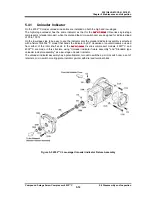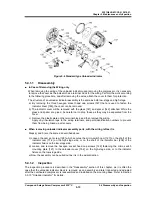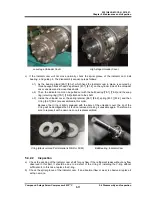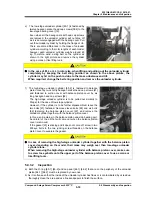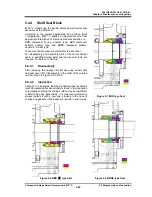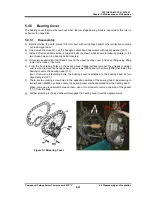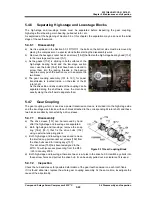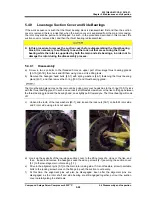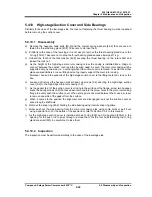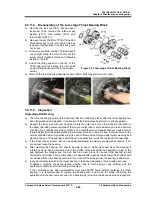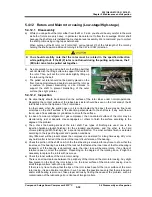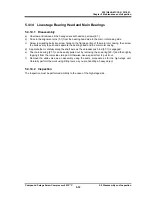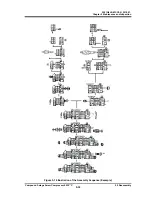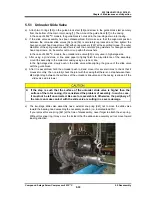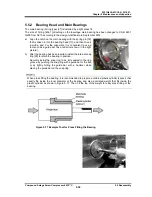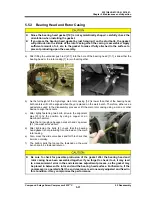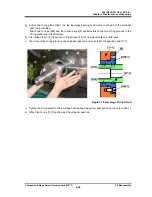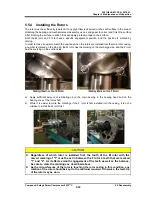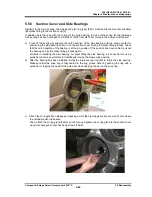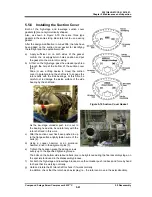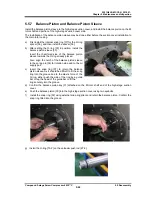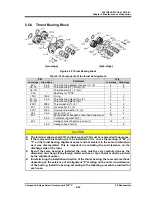
2201Q4JE-MY-C9-N_2018.01.
Chapter 5 Maintenance and Inspection
Compound 2-stage Screw Compressor 4032**C
5.4 Disassembly and Inspection
5-28
5.4.11.2
Disassembly of the Low-stage Thrust Bearing Block
a) Remove the lock nut [39-1] that has been
loosened. Then, remove the torsional slip
washer [237-1], lock washer [40-1], and
thrust washer [250-1].
b) Remove the key [346] for TPTB (Tilting Pad
Thrust Bearing) on the rotor shaft. This key
is easy to lose because it is small. Take care
not to lose.
c) Screw two eyebolts into the TPTB and pull it
out straight along the rotor shaft until the
screw hole for eyebolt comes out (following
picture to the left).
d) Attach the lifting eyebolt on the top of the
TPTB and pull out it along the rotor shaft
using a lifting device (picture in the middle
below).
e) Remove the thrust bearing alignment spacer [42-1] (following picture to the right).
5.4.11.3 Inspection
High-stage Ball Bearing
a) The thrust bearing is normal if the bearing balls are found fully glossy after the thrust bearing has
been fully washed and cleaned. It is abnormal if the ball surface has tarnish or streaky pattern.
b) Support the inner race with your hand and rotate the outer race. If you feel abnormal vibration on
the hand, the rolling contact surface of the inner or outer race or some balls may be in an abnormal
condition. So, carefully check the conditions. You could feel some irregular click even with a small f
foreign matter that has entered during the removal process. In such a case, it should return to the
normal condition when high pressure air is used to blow out the foreign matters after washing and
cleaning the unit. If the bearing is determined to be defective, it must be replaced with new ones.
c) If the inner race and outer race can be easily separated, the wear is considered excessive. If so,
you cannot reuse the bearing.
d) After washing the bearing, you should be able to hear a clattering sound when the bearing is
rotated by hand. Such a sound is due to the motion of the ball within the backlash or play, or the
gap between the retainer and the ball. Such a sound will not be heard if the bearing is held
horizontal and turned. If some lubricating oil is applied after washing the bearing, the sound should
not be heard when the bearing is turned. If you can still hear the sound, the bearing is abnormal.
e) If any abnormality is seen in the thrust bearing in the above inspection, replace with new ones.
In addition, carefully check the reason whether due to mere aging or any problem with the
operating condition and/or lubricating mechanism.
If the compressor has been operated for more than 20000 hours without replacing the thrust
bearing, it is recommended to replace the bearing with a new one for safely continuing the
operation until the next overhaul, even if no abnormality is found in the above described inspection.
Figure 5-14 Low-stage Thrust Bearing Block

